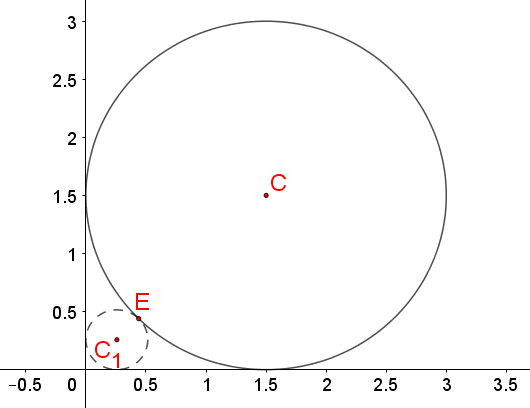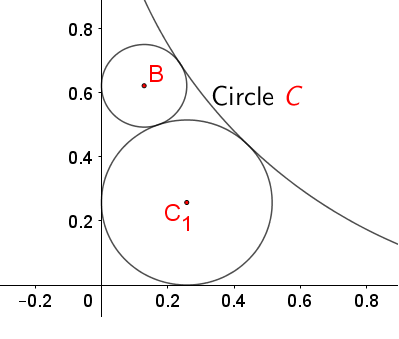Axes Tangent Circles
This section is about drawing circles that are tangent to the $xy$ axis. It could be expanded to $\mathbb{R}^{3}$ or even $\mathbb{R}^{n}$ space but that is not done here and I will stay in $\mathbb{R}^{2}$. We will begin with a circle of center, $(r,r)$, chosen so that if we use radius $r$. The circle will be tangent to the axes. We will name this circle $C$.

Next we will try to construct a circle that is in the space between point $(0,0)$ and circle $C$. We want the new circle to be tangent to both axes and also tangent to circle $C$. To construct the new circle, we need to know its center point and its radius. If we name the radius $r_{1}$ then, since it must be tangent to both axes, its center point must be $C_{1}=(r_{1},r_{1})$. It also must have a point that is tangent to circle $C$ and logically, that point must be on a line between point $C$ and the origin. To find that point, I chose to divide $C$ into $8$ equal segments, $(\pi/4,\,2\pi/4,\,3\pi/4,\,\ldots\,,\,8\pi/4)$ and then just count around until I came to the correct point. The coordinates of point $E$ are thus $[r\cdot \cos(5\pi/4)+r,\,r\cdot \sin(5\pi/4)+r]$ from the perspective of circle $C$. However, from the perspective of circle $C_{1}$ the same point, $E$ has coordinates $[r_{1}\cdot cos(\pi/4)+r_{1},\,r_{1}\cdot sin(\pi/4)+r_{1}]$.
Now that we have the coordinates of a point on the circle, we can write an equation for circle $C_{1}$ and solve for its radius. $$\left(\begin{array}{c} r_{1}\cos(\pi/4)\\ r_{1}\sin(\pi/4) \end{array}\right)+\left(\begin{array}{c} r_{1}\\ r_{1} \end{array}\right)=E=\left(\begin{array}{c} r\cdot \cos(5\pi/4)+r\\ r\cdot \sin(5\pi/4)+r \end{array}\right) \tag{1} \label{1}$$ We can use either row of $\eqref{1}$ to solve for $r_{1}$ as knowing $r$ makes the right-hand side a constant. $$r_{1}cos\left(\frac{\pi}{4}\right)+r_{1}=r\cdot\left(cos\left(\frac{5\pi}{4}\right)+1\right)$$ $$r_{1}=\frac{r\left(\cos\left({\displaystyle \frac{5\pi}{4}}\right)+1\right)}{\cos\left({\displaystyle \frac{\pi}{4}}\right)+1}$$ We can repeat these steps to get an ever decreasing size of tangent circle going infinitely toward the origin, such that no matter how much one scaled in, the same pattern would be seen. Let $$k=\frac{\cos\left({\displaystyle \frac{5\pi}{4}}\right)+1}{\cos\left({\displaystyle \frac{\pi}{4}}\right)+1}$$ Then the next circle down, $r_{2}$ is just $$r_2=r_1k$$ with center point $(r_{2},r_{2})$. The following circle will be $r_{3}=r_{2}k$ and forever. Now suppose we wanted to draw a circle that is tangent to the $y$-axis and also tangent to circles $C$ and $C_{1}$. We can name it circle $B$ with center point $B=(B_{x},B_{y})$ and radius $s$. See figure 2.

The distance from center point $B$ to center point $C$ is the radius of $C$ plus the radius of $B$. $$|B-C|=r+s$$ We also can see that $s$ is the $x$ distance from the $y$-axis to point $B$. That is, $B_{x}=s$. Essentially the same equation is available for the distance from $B$ to $C_{1}$. $$|B-C_{1}|=r_{1}+s.$$ Expanding these two equations and substituting $B_{x}$ for $s$ gives $$B_{x}+r=\sqrt{(B_{x}-C_{x})^{2}+(B_{y}-C_{y})^{2}} \tag{2} \label{2}$$ $$B_{x}+r_{1}=\sqrt{(B_{x}-C_{1x})^{2}+(B_{y}-C_{1y})^{2}} \tag{3} \label{3}$$ and there are only two unknowns, $B_{x}$ and $B_{y}$. Simultaneously solving these equations with symbols is difficult, but if we put in our previously found numeric values, it is easier. $$r=C_{x}=C_{y}=\frac{3}{2}$$ $$r_{1}=C_{1x}=C_{1y}=\frac{r\left(cos\left({\displaystyle \frac{5\pi}{4}}\right)+1\right)}{cos\left({\displaystyle \frac{\pi}{4}}\right)+1}$$ Substituting for $r$ and $r_{1}$ into $\eqref{2}$ and $\eqref{3}$, $$B_{x}+\frac{3}{2}=\sqrt{{\displaystyle \left(B_{x}-\frac{3}{2}\right)^{2}+\left(B_{y}-\frac{3}{2}\right)^{2}}} \tag{4} \label{4}$$ $$B_{x}+\frac{\left({\displaystyle \frac{3}{2}}\right)\left(cos\left({\displaystyle \frac{5\pi}{4}}\right)+1\right)}{cos\left({\displaystyle \frac{\pi}{4}}\right)+1}=\sqrt{\left(B_{x}-\frac{\left({\displaystyle \frac{3}{2}}\right)\left(cos\left({\displaystyle \frac{5\pi}{4}}\right)+1\right)}{cos\left({\displaystyle \frac{\pi}{4}}\right)+1}\right)^{2}+\left(B_{y}-\frac{\left({\displaystyle \frac{3}{2}}\right)\left(cos\left({\displaystyle \frac{5\pi}{4}}\right)+1\right)}{cos\left({\displaystyle \frac{\pi}{4}}\right)+1}\right)^{2}} \tag{5} \label{5}$$ $$\left(\begin{array}{c} B_{x}\\ B_{y} \end{array}\right)=\left(\begin{array}{c} {\displaystyle \frac{-6\sqrt{2}+9}{4}}\\ {\displaystyle \frac{3\sqrt{2}-3}{2}} \end{array}\right)=\left(\begin{array}{c} 0.128679656440357\\ 0.621320343559643 \end{array}\right)$$ In this case, there is also another circle below the $x$-axis that meets the criteria, except that it isn't in the space of interest.